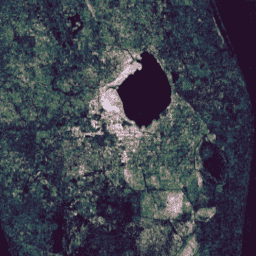
- در دسترس بودن مجموعه داده
- 1999-01-01T00:00:00Z–2020-01-01T00:00:00Z
- ارائه دهنده مجموعه داده
- گوگل
- برچسب ها
توضیحات
این مجموعه شامل نتایج از پیش محاسبهشدهای از اجرای الگوریتم تشخیص و طبقهبندی تغییر مداوم (CCDC) بر روی دادههای بازتاب سطح لندست ۲۰ ساله است. CCDC یک الگوریتم یافتن نقطه شکست است که از برازش هارمونیک با آستانه RMSE پویا برای تشخیص نقاط شکست در دادههای سری زمانی استفاده میکند.
مجموعه داده از مجموعه زمانی Landsat 5، 7، و 8 Collection-1، Tier-1، سری زمانی بازتاب سطح، با استفاده از تمام تصاویر روزانه بین 01-01-1999 و 2019-12-31 ایجاد شده است. هر تصویر برای پوشاندن پیکسلهای شناسایی شده بهعنوان ابر، سایه یا برف (طبق باند «pixel_qa»)، پیکسلهای اشباع، و پیکسلهایی با کدورت جوی > 300 (همانطور که با باندهای «sr_atmos_opacity» و «sr_aerosol» شناسایی میشوند، از پیش پردازش شده بود. پیکسلهای تکرار شده در همپوشانی صحنه شمالی/جنوبی تکرار نشدند. نتایج در کاشی های 2 درجه برای تمام خشکی های بین -60 درجه و عرض جغرافیایی +85 درجه خروجی شد. این تصاویر به سادگی به شکل موزاییک() در یک تصویر سراسری مناسب هستند.
الگوریتم CCDC با پارامترهای الگوریتم پیشفرض به جز dateFormat اجرا شد:
- tmaskBands: ['green', 'swir']
- مشاهدات کوچک: 6
- chiSquareProbability: 0.99
- minNumOfYearsScaler: 1.33
- فرمت date: 1 (سال کسری)
- لامبدا: 20
- حداکثر تکرار: 25000
هر پیکسل در خروجی با استفاده از آرایه های طول متغیر کدگذاری می شود. طول بیرونی هر آرایه (محور 0) با تعداد نقاط شکست یافت شده در آن مکان مطابقت دارد. باندهای ضریب شامل آرایههای دو بعدی هستند، که در آن هر آرایه داخلی شامل فاکتورهای مقیاسبندی برای 8 عبارت در مدل هارمونیک خطی است، به ترتیب: [offset، t، cos(ωt)، sin(ωt)، cos(2ωt)، sin(2ωt)، cos(3ωt)، sin(3ωt)]، که در آن ω = 2. مدل ها برای تولید واحدهای بازتاب (0.0 - 1.0) برای باندهای نوری و درجه (K) / 100.0 برای باند حرارتی هستند.
توجه داشته باشید که از آنجایی که باندهای خروجی آرایه هستند و فقط با استفاده از یک خط مشی هرمی SAMPLE می توان نمونه برداری کرد. در سطوح زوم پایینتر، نتایج معمولاً دیگر نماینده دادههای با وضوح کامل نیستند، و برای مثال، مرزهای کاشی را میتوان به دلیل ماسکهای نمونهبرداری شده مشاهده کرد. بنابراین استفاده از این مجموعه داده در وضوح کمتر از 240 متر بر پیکسل توصیه نمی شود.
هیچ برنامهای برای افزودن داراییهای پس از سال ۲۰۱۹ به این مجموعه داده وجود ندارد.
باندها
اندازه پیکسل
30 متر
باندها
| نام | اندازه پیکسل | توضیحات |
|---|---|---|
tStart | متر | آرایه 1 بعدی حاوی تاریخ شروع هر بخش (سال کسری). |
tEnd | متر | آرایه 1 بعدی حاوی تاریخ پایان هر بخش (سال کسری). |
tBreak | متر | آرایه 1 بعدی حاوی تاریخ نقطه شکست شناسایی شده هر بخش (سال کسری). |
numObs | متر | آرایه 1 بعدی حاوی تعداد مشاهدات یافت شده در هر بخش. |
changeProb | متر | یک شبه احتمال واقعی بودن نقطه شکست شناسایی شده. |
BLUE_coefs | متر | آرایه دو بعدی حاوی ضرایب مدل هارمونیک برای نوار آبی، برای هر بخش. |
GREEN_coefs | متر | آرایه دو بعدی حاوی ضرایب مدل هارمونیک برای نوار سبز، برای هر بخش. |
RED_coefs | متر | آرایه دو بعدی حاوی ضرایب مدل هارمونیک برای نوار قرمز، برای هر بخش. |
NIR_coefs | متر | آرایه دو بعدی حاوی ضرایب مدل هارمونیک برای باند مادون قرمز نزدیک، برای هر بخش. |
SWIR1_coefs | متر | آرایه 2 بعدی حاوی ضرایب مدل هارمونیک برای باند موج کوتاه مادون قرمز (1.55μm-1.75μm)، برای هر بخش. |
SWIR2_coefs | متر | آرایه 2 بعدی حاوی ضرایب مدل هارمونیک برای باند موج کوتاه مادون قرمز (2.09μm-2.35μm)، برای هر بخش. |
TEMP_coefs | متر | آرایه 2 بعدی حاوی ضرایب مدل هارمونیک برای باند حرارتی، برای هر بخش. |
BLUE_rmse | متر | آرایه 1 بعدی حاوی RMSE مدل برای نوار آبی، برای هر بخش. |
GREEN_rmse | متر | آرایه 1 بعدی حاوی RMSE مدل برای باند سبز، برای هر بخش. |
RED_rmse | متر | آرایه 1 بعدی حاوی RMSE مدل برای نوار قرمز، برای هر بخش. |
NIR_rmse | متر | آرایه 1 بعدی حاوی RMSE مدل برای باند مادون قرمز نزدیک، برای هر بخش. |
SWIR1_rmse | متر | آرایه 1 بعدی حاوی RMSE مدل برای باند موج کوتاه مادون قرمز (1.55μm-1.75μm)، برای هر بخش. |
SWIR2_rmse | متر | آرایه 1 بعدی حاوی RMSE مدل برای باند موج کوتاه مادون قرمز (2.09μm-2.35μm)، برای هر بخش. |
TEMP_rmse | متر | آرایه 1 بعدی حاوی RMSE مدل برای باند حرارتی، برای هر بخش. |
BLUE_magnitude | متر | آرایه 1 بعدی حاوی مقدار نقطه شکست شناسایی شده برای نوار آبی، برای هر بخش. |
GREEN_magnitude | متر | آرایه 1 بعدی حاوی مقدار نقطه شکست شناسایی شده برای نوار سبز، برای هر بخش. |
RED_magnitude | متر | آرایه 1 بعدی حاوی مقدار نقطه شکست شناسایی شده برای نوار قرمز، برای هر بخش. |
NIR_magnitude | متر | آرایه 1 بعدی حاوی مقدار نقطه شکست شناسایی شده برای باند مادون قرمز نزدیک، برای هر بخش. |
SWIR1_magnitude | متر | آرایه 1 بعدی حاوی مقدار نقطه شکست شناسایی شده برای باند موج کوتاه-مادون قرمز-1 (1.55μm-1.75μm)، برای هر بخش. |
SWIR2_magnitude | متر | آرایه 1 بعدی حاوی مقدار نقطه شکست شناسایی شده برای باند موج کوتاه-مادون قرمز-2 (2.09μm-2.35μm)، برای هر بخش. |
TEMP_magnitude | متر | آرایه 1 بعدی حاوی مقدار نقطه شکست شناسایی شده برای باند حرارتی، برای هر بخش. |
شرایط استفاده
شرایط استفاده
